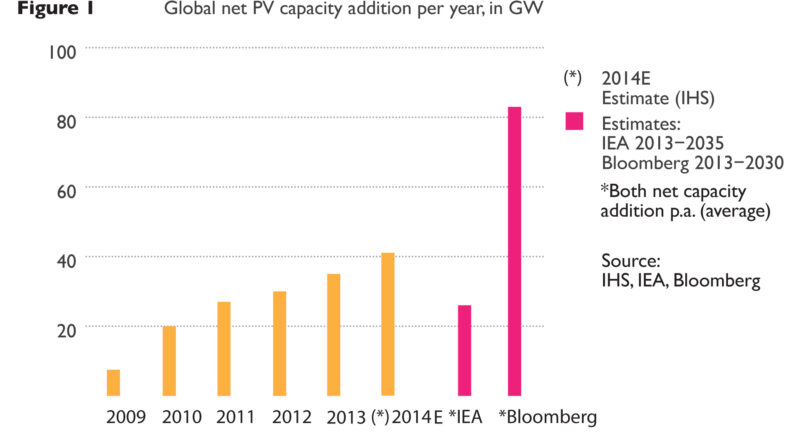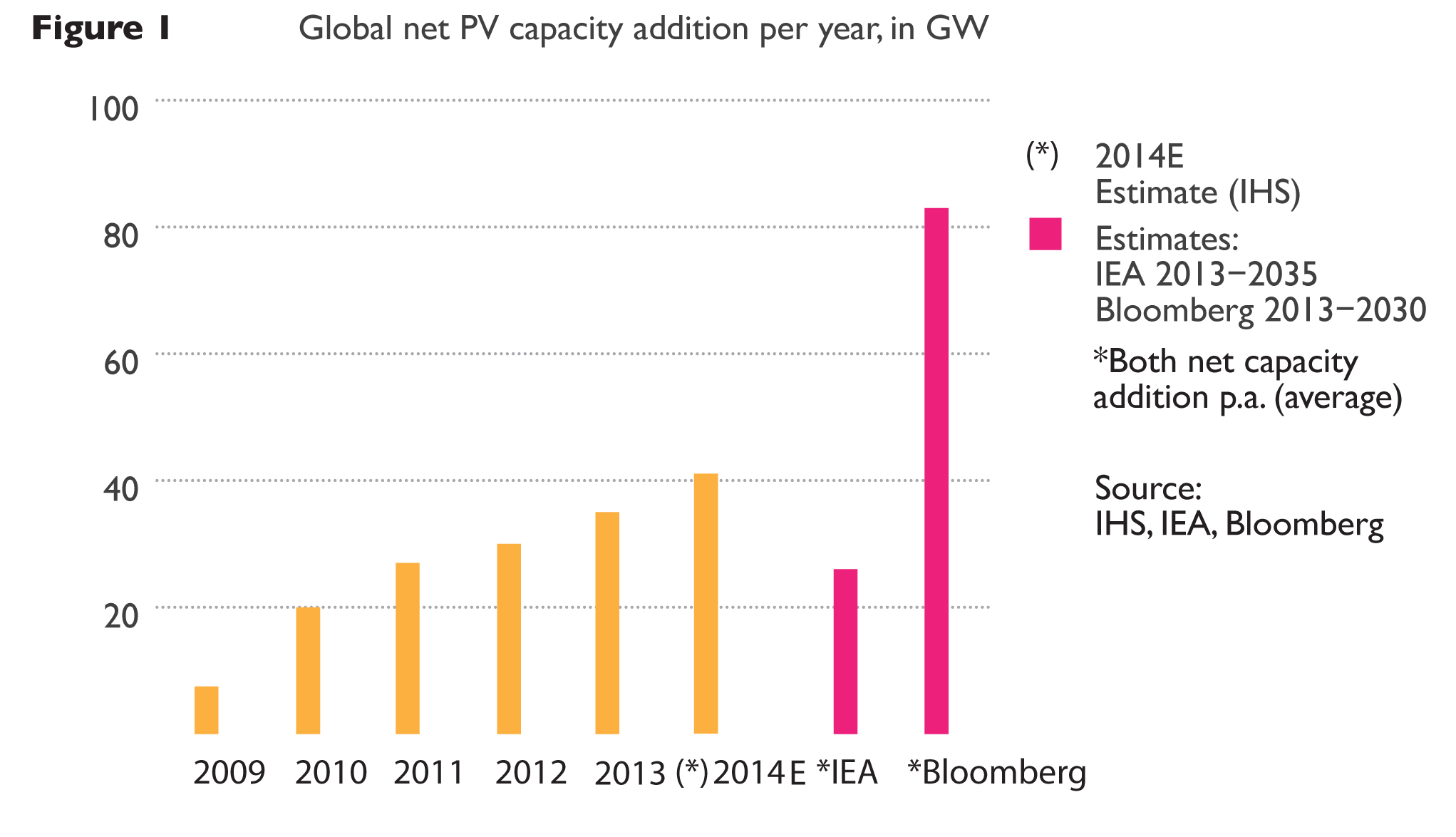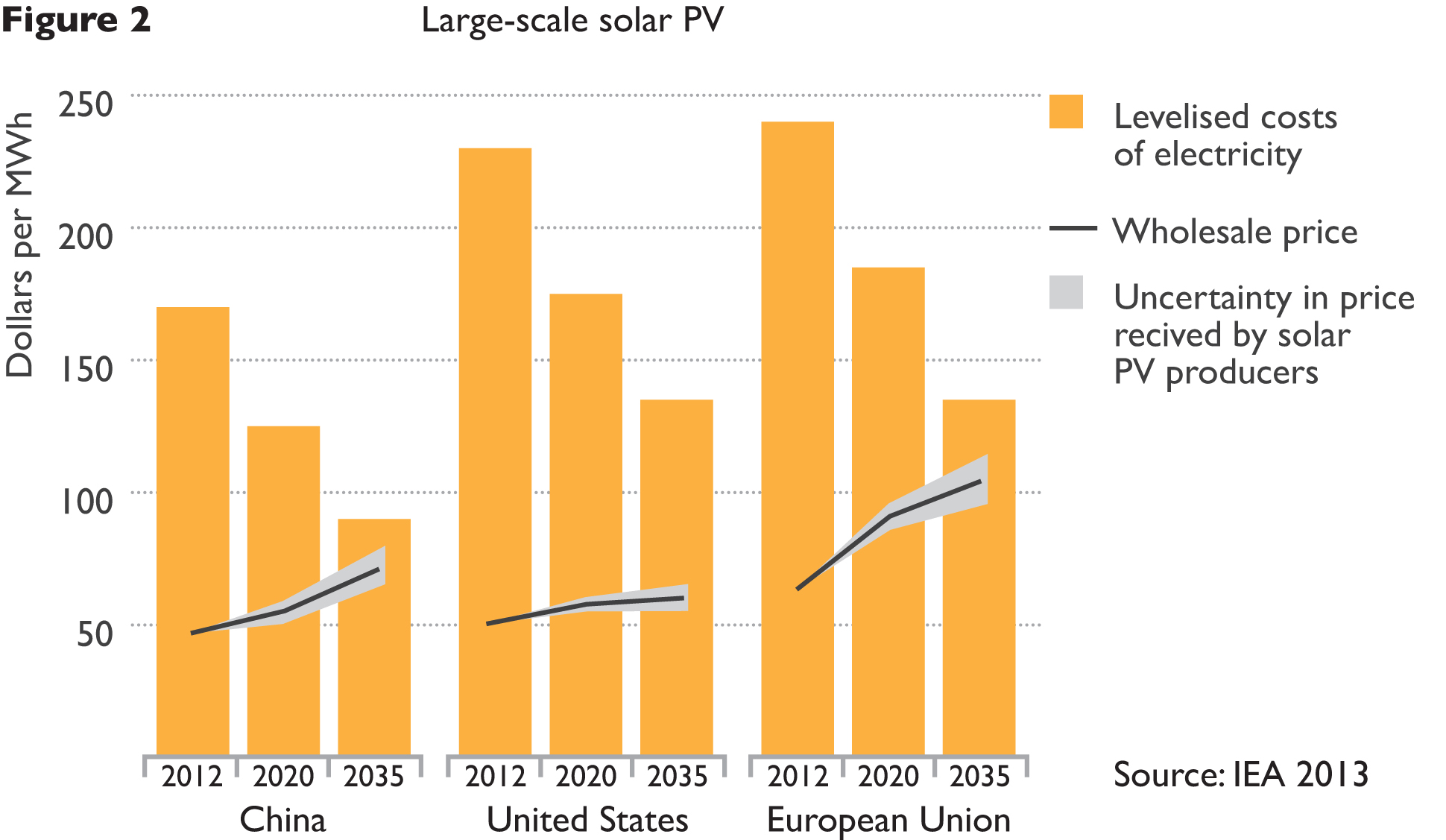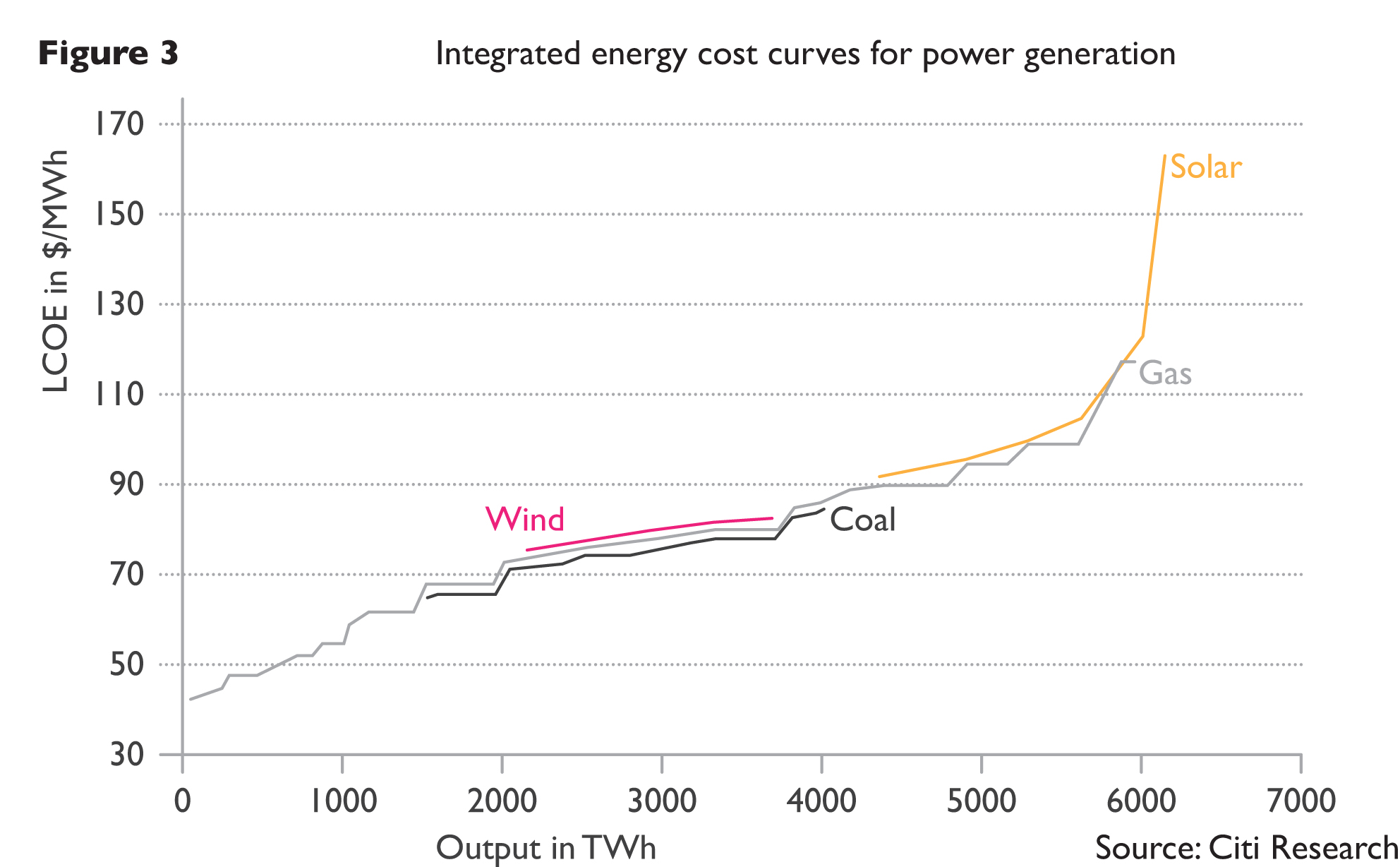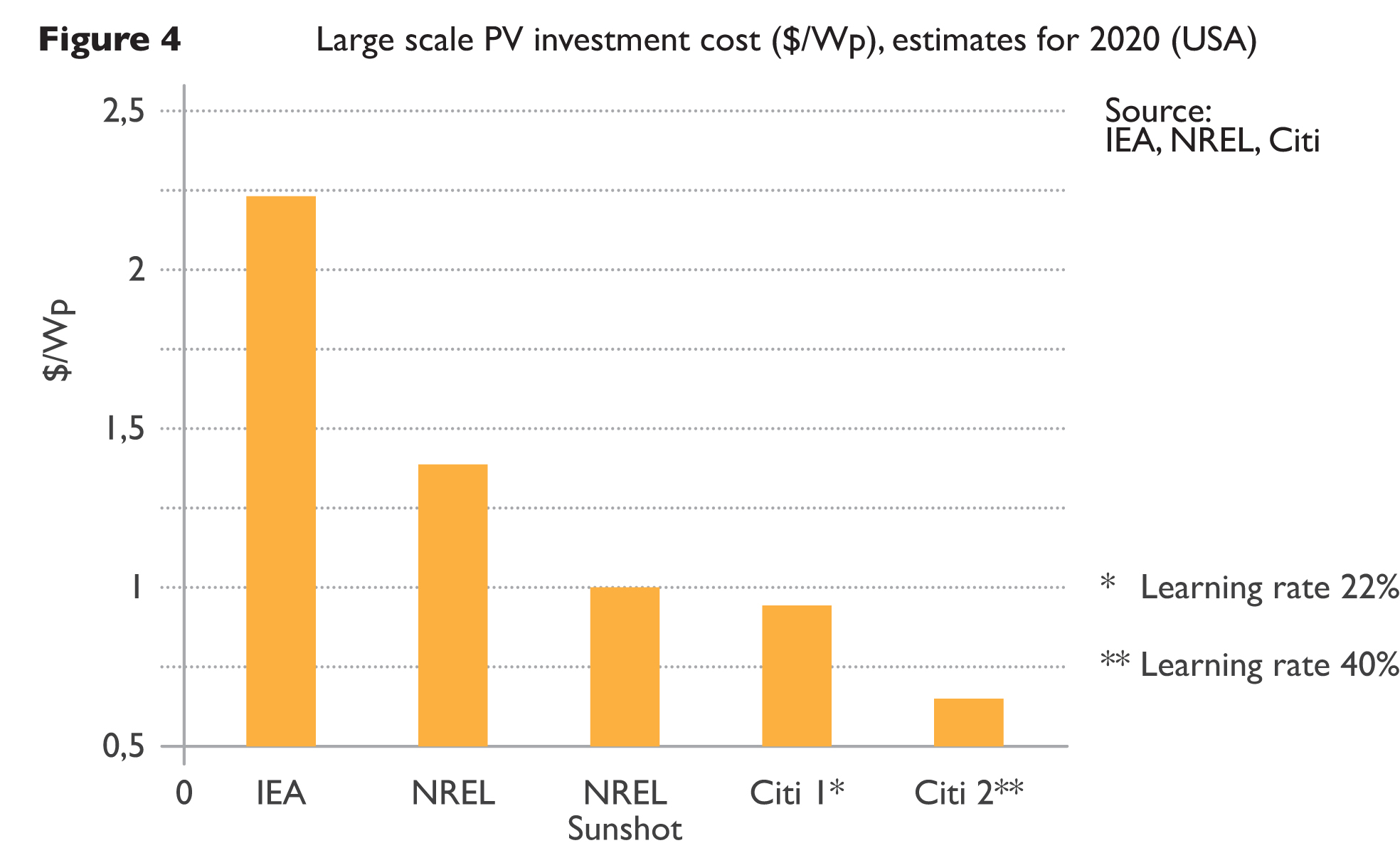How The IEA Underestimates The Solar Industry
Originally published on Energy Post.
By Terje Osmundsen.

The International Energy Agency (IEA) consistently entertains much too pessimistic assumptions about the growth potential and cost development of solar power, writes Terje Osmundsen, Senior Vice President of the Norwegian-based international solar power company Scatec Solar. According to Osmundsen, the cost assumptions used by the IEA are 100% higher than even current market prices. He notes that as a result of the IEA’s misleading information, policymakers are under the false impression that the spread of solar power will require huge subsidies. He calls on the IEA to get together with the International Renewable Energy Agency (IRENA) to conduct a joint study on the real economics of solar power.
The International Energy Agency (IEA), probably the most influential energy think tank in the world, is not an overt enemy of renewable energy. The IEA often has nice words to say about the importance of renewables. Yet its flagship publication, the World Energy Outlook (WEO), foresees only rather moderate progress of renewables – and of solar power in particular. But how reliable is the WEO’s assessment?
In various parts of the world – US, Chile, South Africa, India among others – utilities are these days signing Power Purchase Agreements with solar power producers at tariffs competitive to the cost of electricity from new-built gas and coal power plants. But according to the IEA this can hardly be true, because their analysis claims that the cost of large-scale solar PV is more than the double that of the alternatives. Therefore, the substitution of fossil fuels with solar PV will be slow to materialise and it will be very costly, states the World Energy Outlook (WEO).
With cost assumptions 100% above current market prices, it’s perhaps not surprising IEA’s model projects such a modest market development of PV compared to benchmark studies.
It is high time that this fundamental shortcoming of the WEO is corrected, as it spreads the deceptive message that for every MWh of solar PV being generated, taxpayers or consumers will pay on average 130 US dollars in subsidy per year over the next 20 years.
In reality, we are already at the point in some markets where solar PV has started to compete against fossil fuel alternatives without subsidies, a situation that will spread to ever more markets as the cost of solar continues to fall and the cost of fossil fuels continues to rise. In this article I will focus on solar PV, but I am aware similar criticism has been raised regarding the WEO’s market forecasts for other kinds of renewables.
World Energy Outlook projects negative growth in solar
In the WEO’s main scenario, the New Policies Scenario, renewables including hydropower represent 50% of all new power generation added in the period from 2012 to 2035, and 62% of total generation investments. But due to several factors – the legacy of existing infrastructure, total demand growth and the lower capacity factors of intermittent wind and solar – the contribution from renewables in terms of power generation remains moderate, 31% compared to circa 20% in 2011.
When it comes to solar PV, the IEA even predicts a slow-down. As seen in figure 1, the industry grew on average 25% per annum since 2010, and is expected to reach about 40 GW this year. In the WEO’s New Policies Scenario, the average yearly increase falls back to the 2011 level, equal to a negative growth rate.
According to tables 5.4 and 5.5 in the 2013 edition of the WEO (WEO 2013), the average yearly increase (gross additions minus retired plants) of solar PV globally from now to 2035 will be in the range of 26 GW the next 23 years.
As we will see below, this is between two and three times less than the capacity additions projected by comparable benchmark studies. The main reason for this conservatism appears to be IEA’s outdated assumptions on the costs of PV.
According to the IEA, solar PV is still very expensive, close to 0.25$/kWh in Europe and the US, and will remain so for long (see table 1 below). In 2020, IEA expects the levelised cost of electricity (LCOE, see below for a definition) for large-scale PV will have declined to 0.13-0.19$ per kWh, in China, US and Europe. IEA predicts a moderate increase in wholesale electricity prices in Europe and China, and practically stable prices in the US. What IEA then defines as subsidy, is the difference between the calculated levelised cost of electricity for PV on the one hand, and the forecasted wholesale electricity prices. Given these cost assumptions, IEA concludes that all solar PV generated between now and 2035 will receive on average 0.13$/kWh in subsidies, equivalent to 1600 billion US dollars in subsidies for the period to 2035. Presented with such a giant price tag, no wonder politicians, economists and lobbyists continue to claim that renewables are too expensive.
The first question this raises is whether electricity wholesale prices are the relevant benchmark for estimating the level of subsidy. In many countries wholesale prices are distorted by various forms of subsidy or regulation. In fast growing emerging markets, utilities and large consumers are forced to rely on generators using heavy fuel oil or diesel to meet the growing demand – solutions with a price tag several times the official wholesale energy price.
Furthermore, solar tariffs are fixed for 20-25 years, contrary to wholesale prices that fluctuate and are exposed to fuel price and CO2 risks. Many utilities and off-takers will therefore consider a Power Purchase Agreement with a fixed 20 year-tariff not a “subsidy” but rather a commercial instrument to mitigate fuel and CO2 price risks, even if the tariff is higher than expected market prices over the next decades.
However, most importantly, the assumptions on the cost of PV used in the IEA’s World Energy Outlook are severely outdated. As can be seen from figure 2, the organisation estimates the average cost of PV in US and Europe to be in the range of 0.23-0.24$/kWh in 2012. China is at the bottom level at around 0.17$/kWh, and the other sunny regions in between.
The problem is: these cost numbers are 2-3 times higher than current market prices.
In the US, the average negotiated tariff (inflation-adjusted) of large-scale solar PV fell to below 0.06$/kWh in 2013, according to a study by the National Laboratory of the U.S. Department of Energy (NREL 2012). Adding the value of the 30% tax credit available in the US, this still gives a competitive tariff of less than 0.10$ per kWh. In 2013, more than 4 GW of solar PV was added to the grid in the US, which made it the second biggest contributor of new generation capacity next only to natural gas.
A similar pattern can be seen elsewhere, although differences in solar radiation and installation and finance costs account for significant variations in tariffs. In a recent study, the German Fraunhofer Institute calculates that the levelised cost of PV from ground-mounted utility-scale PV in Southern Germany fell to 0.08-0.11 €/kWh (0.11-0.14$/kWh) in 2013 (Fraunhofer ISE 2013). In Southern Europe the cost is somewhat lower despite higher finance costs, 0.06-0.08 €/kWh (0.08-0.10$/kWh), close to a third of the cost reported by the IEA.
What this cost curve tells us is that a large portion of the coal and gas power projects planned towards 2020 will reach a cost level where they can be substituted by wind or solar at no or very limited cost.
Looking at emerging markets, South Africa is an interesting case in point. In the first round of the new Renewable Energy Program tendered in 2011, the average tariff of the selected bids was close to 0.30$/kWh. In the second round one year later, the tariff fell to below 0.20$, and in the third round in 2013 the average tariff offered by the selected bidders came close to 0.10$/kWh. In addition, the share of locally produced goods and services has increased to 50%, laying the foundation for thousands of new jobs in solar-related businesses. In rapidly growing markets like China, India and Chile, we see the same pattern as in South Africa: when the policy framework has been set and proven, and market volumes are allowed to grow, the cost of utility-scale solar PV in markets with above average solar radiation seem to converge around 0.11-0.12$/kWh. This corresponds to Fraunhofer’s calculation for regions with “high solar radiation”, like the Middle East and North Africa. In these markets, the levelised cost of electricity is estimated to be in the range 0.08-0.10$/kWh.
In Japan, following the Fukushima accident, the government needed to swiftly make investments in renewables attractive also to Japanese businesses. Hence the government decided to set a high introductory tariff for solar PV, 0.40$/kWh, but in Japan costs too will fall rapidly.
IEA forecasts vs. benchmark reports
With cost assumptions 100% above current market prices, it’s perhaps not surprising IEA’s model projects such a modest market development of PV compared to benchmark studies. Bloomberg New Energy Finance, for example, projects in their reference scenario that renewables will represent 70% of all new generation capacity in the period up to 2030, compared to the IEA’s 50% for a period that extends to 2035 (BNEF 2013). Bloomberg projects the industry will add 1450 GW by 2030, equal to 80 GW per annum – 2.5 times more than the IEA’s projection.
 Chip in a few dollars a month to help support independent cleantech coverage that helps to accelerate the cleantech revolution!
Chip in a few dollars a month to help support independent cleantech coverage that helps to accelerate the cleantech revolution!
However, the level of investments required is more or less the same in both studies, 1.26-1.3 billion US dollars, which implies that Bloomberg gets 2.5 times more PV per buck than does the IEA. Bloomberg predicts that PV’s share of total power generation will increase to 6% in 18 years, compared to only 2.5% in 23 years predicted by the IEA.
In an interview with the Norwegian daily Dagens Naeringsliv on 16 January, IEA Chief Economist Fatih Birol said that if the IEA has other conclusions than industry and financial analysts, it’s “because we have other underlying assumptions or because they only look at one technology whereas we look at the power generation sector in totality.” One such alternative benchmark study was provided by Citi Research last October (Citi 2013). The study, called “Energy Darwinism”, did exactly what Fatih Birol recommended, namely to look at solar as part of the power sector in totality.
To reach the integrated cost curve shown in figure 3, the researchers studied the coal and gas power projects planned to come on stream between now and 2020. The estimated levelized costs of electricity for the range of projects are plotted along the vertical axis, and the projects’ cumulative estimated output along the horizontal axis. In addition, Citi plotted the range of actual and emerging generation costs for solar PV and wind.
The result: in 2020 Citi projects that solar PV will cost 0.07-0.09$/kWh, similar to Bloomberg’s assumptions, close to 50% of IEA’s cost estimate for 2020.
What this cost curve tells us is that a large portion of the coal and gas power projects planned towards 2020 will reach a cost level where they can be substituted by wind or solar at no or very limited cost. Consequently, Citi forecasts that renewables will count for 61% of all new investments in power generation in the period to 2030. PV will attract 13% of all investments in the power generation sector in the period to 2030, most of which is non-subsidized and driven by fuel substitution, says Citi.
What went wrong?
When I first wrote a commentary on IEA’s WEO in 2012, I questioned why IEA did not publish the underlying assumptions behind the modelling (Osmundsen 2012). This year IEA deserves credit for having done so. The document “WEO 2013 PG Assumptions”, available on the IEA website, sheds light on the divergences.
First, the model’s investment costs for large-scale PV, between 2.5 and 3 dollar per watt in OECD, are overstated. According to the Fraunhofer Institute the actual investment cost is about 40% lower, 1-1.70 € (1.35-2.20$) per watt. This coincides with actual costs we see in the market.
In addition, the IEA believes the learning curve of the industry, i.e. the percentage cost reduction for every doubling of PV capacity, will decline to 18%, compared to 40% the last years. As a result, the IEA assumes investment costs for PV in 2020 that are still higher than what the actual costs are in 2013, and far higher than benchmark forecasts.
Citi estimates the investment cost will drop to 0.93$ per watt, if we assume a learning rate of 22%. With a 40% learning rate, the cost will fall to an average 0.65$ per watt by 2020.
Reading the Outlook, one gets the clear impression that the IEA is more concerned about inconveniences of solar and wind, and less aware of the benefits
The US “Sunshot” program is an industrial innovation partnership between the Department of Energy, R&D laboratories and the industry. Their business-as-usual scenario assumes no innovation breakthroughs by 2020, in which case the average investment cost of utility-scale PV will drop to 1.38$ per watt. In their innovation roadmap the investment cost declines to 1$ per watt in 2020.
In 1976, the price of a PV module was 65$ per watt. In 2008 it had dropped to 4$. At the end of 2013, the price was approximately 0.65$ per watt. Will the cost continue to fall? To answer the question it is important to understand the dynamics at work in PV technology and manufacturing. There is still a large potential for both process innovation and product innovation. The process of manufacturing the PV panels will become more resource-efficient and automated, and hence cheaper. Take wafer manufacturing for example, which today consumes 6-7 gram silicon per watt. By reducing the thickness of the wafers the consumption of silicon can be slashed. A few innovative companies seem close to making such potentially disruptive technologies commercial.
On the performance side, cell design is continuously improved with new features, leading to higher yields and better resistance. The panel’s efficiency in converting solar radiation to electricity – estimated at 16-18% today for panels using crystalline cells (as opposed to thin-film) – will continue to rise as well. With today’s crystalline technology, the maximum theoretical efficiency is 31%. However, significant R&D resources are invested in developing high-efficiency cells. One direction is to introduce nano-scale technologies; another is to integrate multiple junctions (“layers”) into one cell. With each new junction, the cell can capture a much larger bandwidth of solar radiation. We can therefore safely assume that commercial PV panels sold in large volumes will also continue to increase their efficiency.
Various reports support the view that costs will continue to fall. GTM Research estimates in a report of June 2013 that “production costs for industry-leading Chinese crystalline-silicon (c-Si) PV module manufacturers will fall from 50 cents per watt in the fourth quarter of 2012 to 36 cents per watt by the end of 2017″ (Greentech Solar 2013). Consequently, McKinsey suggest the investment cost for PV commercial-scale rooftop systems will fall by 40 percent from 2012 to 2015, and by approximately another 30 percent by 2020 (McKinsey 2012).
Deutsche Bank states in a report from January 2014 that solar is currently competitive without subsidies in at least nineteen markets globally (Greentech Solar 2014). The bank expects more markets to reach grid parity in 2014 as solar system prices decline further.
Solar panels now represent less than 50% of the investment cost of PV systems. The remaining share – the so-called Balance-of-System – are inverters, structures, civil work, installation, transformers, cabling, etc. Their costs have also come down significantly in recent years, and will continue to do so. Economies-of-scale and the fact that the size of inverters, structures, cables, etcetera falls as direct proportion of more efficient panels, are two predictable drivers. But most importantly, new and existing players will continue to introduce smarter structures, trackers and installation technologies, as well as more efficient inverters and transformers.
Finally, assuming only a 20-year lifetime for PV, IEA projects that 160 GW of solar power will be decommissioned by 2035. This is highly unlikely. Based on various studies, experts today consider the long-term resilience of PV to be high (CAT 2014). Although the panel manufacturers’ performance guarantee expires after 25 years, PV plants will most probably continue to generate electricity for 30-40 years, if not more. Parts of the equipment will be replaced over time, but the infrastructure of the solar plant will remain.
| Table 1. WEO vs. benchmark studies | IEA (WEO 2013) | Benchmarks |
| Investment cost 2020 ($/Wp) | 2.23 (US) | NREL high: 1.38NREL low: 1.0Citi: 0.93 (learning rate 22%)Citi: 0.65 (learning rate 40%) |
| Renewables as share of new capacity | 50% (to 2035) | BNEF: 70% (to 2030) (PV: 27%) |
| Accumulated investments PV from 2013 | 1 300 bn $ to 2035 | 1 259 bn $ to 2030 |
| Renewables as share of total generation | 30% by 2035(PV: 2.6%) | BNEF: 36% by 2030 (PV: 6%) |
| Average subsidy to PV 2013-2035 ($/kWh p.a) | 0.13 ($1 600 bn accumulated) | |
| Additional PV capacity 2013-2030 | 752 GW by 2035 | 1450 GW by 2030 |
In short, the IEA’s World Energy Outlook should reconsider its model and assumptions, and stop portraying PV as a very costly alternative. From an Outlook with a time horizon to 2035, one would expect a discussion on how the energy sector and societies as a whole could prepare for a situation some years ahead when solar PV has become the preferred and least expensive option of electricity generation in large parts of the world.
Of course, the “system costs” related to a higher share of variable renewables, notably grid capacity and dispatchable or stored capacity to balance intermittent wind and solar, emphasized by the IEA are important and will require significant investment and new business models. But reading the Outlook, one gets the clear impression that the IEA is more concerned about inconveniences of solar and wind, and less aware of the benefits.
IEA and IRENA are both international organizations with a mandate from governments to provide policy-relevant advice on how to speed up the required transformation to a low-carbon energy system. However, as shown in this report, IEA’s World Energy Outlook and IRENA’s REmap are two worlds apart.
Photovoltaic power is extremely reliable (practically no down-times) and seen from the system operator’s point of view it supports frequency stabilisation. Often produced closer to the users, it alleviates the pressure on the grid, and can be scaled up fast and easily to meet incremental growth in demand. Solar PV replaces health-threatening pollution and alleviates the heavy foreign exchange burden on fuel-importing countries. It creates employment in engineering, manufacturing, assembling, installation and operation and maintenance. In the US for example, solar companies added close to 24,000 new jobs in 2013, of which 50% in installation. This is an increase of 20% in a year, ten times more than the national average for job growth (PV Magazine 2014).
IEA and IRENA should join forces
I think there’s a good chance IEA will review its model before next year’s Outlook. The main reason for my optimism is that now also government-related agencies and energy experts are beginning to paint a quite different picture than the mainstream view we are used to from the IEA. In January this year, the government-sponsored International Renewable Energy Agency (IRENA) published its first comprehensive REmap 2030, based on an in-depth review of 26 countries which account for 74% of projected global total final energy consumption in 2030 (IRENA 2014).
The IRENA Roadmap shows that the world can double the share of renewables as part of total energy consumption by 2030 at limited substitution cost – on average 2.5$ per gigajoule (GJ) – for the countries concerned. Taking externalities like health and cost of emitting CO2 into account, the net savings for societies in doubling the share of renewables are estimated between 3-15$ per GJ. In addition, the REmap scenario will lead to an annual average of 900,000 additional direct jobs. In IRENA’s analysis, renewables are at least as important as energy efficiency in CO2 reduction in potential terms, and their importance will only grow after 2030.
In the power sector, the IRENA roadmap projects a trajectory of renewables increasing from 18 to 44% of total generation by 2030. Not surprisingly, wind and solar PV will play the key role, increasing at least five- and twelve-fold, adding about 70 and 60 GW, respectively, of new wind and PV capacity on average each year between today and 2030. But perhaps more important: IRENA calculates that the average substitution costs for this twelve-fold increase of solar PV will be in the range of 2.5$ per GJ. This equals around 8.5$ per MWh – ca 7% of the “PV subsidy” calculated by the IEA. Taking health and the costs of CO2 emissions into account, IRENA estimates the savings related to replacing fossil fuels with renewables to be in the range 1.7-20$ per GJ, or 6-70$ per MWh.
IEA and IRENA are both international organizations with a mandate from governments to provide policy-relevant advice on how to speed up the required transformation to a low-carbon energy system. However, as shown in this report, IEA’s World Energy Outlook and IRENA’s REmap are two worlds apart. Governments and stakeholders would be better served if the two organizations put their heads together, and published a joint study on the economics of and potential for renewables in the power sector.
About the author
Terje Osmundsen, a former publicist, consultant, adviser to Norway’s Prime Minister and executive manager in the energy and engineering business, now heads strategic business development in the international solar power company Scatec Solar AS. He is a recognized thought leader, and writes regularly for the web magazine Energi og Klima. He wishes to thank John Andersen, Ole Grimsrud and Jørgen Dale at Scatec for valuable comments.
This report was first published by the Norwegian Climate Foundation (Norsk Klimastiftelse, report no. 1/2014) and is republished here with exclusive permission from the author. The original can be found here.
Note on LCOE
The levelized cost of energy (LCOE) is a calculation of the cost of generating electricity at the point of connection. It serves to compare the cost of electricity of alternative sources, and include investment costs, operations and maintenance (O&M) costs, performance and fuel costs discounted with a harmonized discount rate, normally 10 %. The higher the discount rate, the more costly appears the most capital-intensive sources of energy in the comparison. Compared to the most common alternatives – wind, bio, gas and coal – photovoltaic energy is clearly the most capital-intensive per kWh, but has no fuel costs and very little O&M costs.
References
Bloomberg New Energy Finance (BNEF): Global trends in renewable energy investment, 2013. Retrieved from: http://www.unep.org
Centre for Alternative Technology (CAT): How long do solar electric PV panels last? Retrieved from: http://info.cat.org.uk, February 2014.
Citi: Energy Darwinism. The evolution of the energy industry, 2013. Retrieved from: https://www.citivelocity.com/citigps/
Dagens Næringsliv (DN): “Tar feil gang på gang”, January 16, 2014.
Fraunhofer ISE: Levelized cost of electricity. Renewable energy technologies. Study, 2013. Retrieved from: http://www.ise.fraunhofer.de
Greentech Solar: “Deutsche Bank Predicts Second Solar ‘Gold Rush’”, January 9, 2014. Retrieved from: http://www.greentechmedia.com
Greentech Solar: “Solar PV Module Costs to Fall to 36 Cents per Watt by 2017″, June 17, 2013. Retrieved from: http://www.greentechmedia.com
International Energy Agency (IEA): World Energy Outlook 2013. Retrieved from: http://www.worldenergyoutlook.org
International Renewable Energy Agency (IRENA): REmap 2030. A renewable energy roadmap, report, 2014. Retrieved from: http://irena.org/remap/
McKinsey: “Solar power: Darkest before dawn”, McKinsey Quarterly, spring 2012. Retrieved from: http://www.mckinsey.com
National Renewable Energy Laboratory (NREL): Residential, Commercial, and Utility-Scale Photovoltaic (PV) System Prices in the United States: Current Drivers and Cost-Reduction Opportunities, report, February 2012. Retrieved from http://www.nrel.gov/
Osmundsen, Terje: “IEA misses the point on solar”, Energi og Klima, November 19, 2012. Retrieved from: http://energiogklima.no
PV Magazine: “US solar jobs up 20% in 2013″, January 30, 2014. Retrieved from: http://www.pv-magazine.com
Sauar, Erik: “Skivebom fra energibyrået”, Dagens Næringsliv, January 16, 2014.
Have a tip for CleanTechnica? Want to advertise? Want to suggest a guest for our CleanTech Talk podcast? Contact us here.
Latest CleanTechnica.TV Video

CleanTechnica uses affiliate links. See our policy here.

